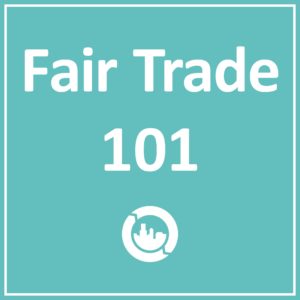Fair Trade Coffee in the Dominican Republic: From Seed to Bean
In March, Fair Trade Towns USA sent 12 volunteer organizers on a 7 day learning tour of Fair Trade farms in Dominican Republic. The travelers came from town and city campaigns all over the country to see the effects of their hard work visiting cocoa, coffee and banana farms, as well as a sweat-free apparel factory.
This blog post comes to us from Kim Anderson of Ballston Spa Fair trade Town Coalition. Kim’s blog takes us through our visit to FEDCARES, a Faie Trade coffee cooperative.
The first time my husband, Chris, and I roasted our own green beans you could smell them from over a half mile away. It was that aromatic scent that primes the mouth for what will become one of the freshest cups of coffee that one can drink. We prefer to roast our own coffee because roasting, grinding and brewing are about all we can do when it comes to preparing coffee for consumption. If our climate would support it, we would likely grow our own. Being committed to organic growing and fair trade economic practices, we thought we had a good handle on the path that our coffee beans take from plant to cup, but I learned much more with the recent Fair Trade Towns USA , “trip to origin” to the Dominican Republic. I returned with several pounds of ready-to-roast “oro”. It’s no wonder that the green beans are referred to as “gold” in that coffee is the second most traded world commodity after crude oil.
The group of 12 fair trade town campaign activists spent two full days learning about FEDECARES which, when the acronym is translated, stands for the Federation of Coffee Growers of the Southern Region (of the Dominican Republic). On Sunday, April 1, after attending the local coffee cooperative’s community meeting in La Esperanza (see related blog by Ruixi Hao) we traveled up the mountain on beautifully narrow and winding roads, to Juan Arias’ finca or farm; an absolute paradise. When I think of a farm I have a vision of rows of crops evenly spaced allowing walking room for harvesting. Perhaps it was the fact that coffee grows on a mountainside that changed my vision of a coffee farm, or maybe it was the fact that among the coffee were all of the following trees and plants: macadamia, banana, yautía (a common Dominican root vegetable similar to yucca), lemon, starfruit, bay laurel (where bay leaves come from), both sweet and acidic oranges and tropical flowers that were gigantic and perfect. Those were only the fruits and nuts that I recognized and they were all growing side by side under a taller shade canopy. This biodiverse, organic existence not only protects the soil and its plants, but also the humans that till, plant, prune, harvest and, ultimately, drink the resulting cup of coffee. Healthy land, healthy families, healthy kids.
After seeing the coffee trees and wishing it were between November and February so that I could participate in transplantedpeak harvest, our group headed to the plant nursery to see the coffee plants in their infancy. The nursery was a large area of land with shade netting staked up to protect the baby plants from too much sun. An extensive irrigation system ran through the greenhouse which housed thousands of plants ranging from one inch in size to just a few inches tall. Coffee beans (seeds) are first planted in a sandy mixture outside of the greenhouse area. Once about one inch of growth appears, each plant is individually transplanted to its own soil mixture in a plastic bag where it begins to mature in the greenhouse. It is these plants that will be planted on hundreds of coffee fincas in the southern region of the Dominican Republic.

Juan Franco Pujols, Secretary of FEDECARES & General Director of La Esperanza Photo Courtesy of Kendra Frink
Leap ahead three to four years, until the coffee tree produces its first harvest and join me at the, “Agroindustrial La Esperanza” building in the town of Los Cacaos where the coffee beans will be prepared for export. After being hand-harvested, which allows for choosing only the most mature red cherries, as they are referred to, the coffee is depulped and fermented. Then, the natural drying process occurs outside on a cement patio area which receives direct sunlight. This drying process can take up to four weeks and the result is coffee in the parchment stage, meaning that the cherry’s pulp has dried out and a thin husk or hull remains. The beans are then transported to a machine that separates the hull, also called parchment.
Bags of parchment are stored and used as fuel to speed up the drying process of the cherries when the weather does not permit the outdoor, natural drying. The beans are then sent down a small conveyor belt which begins the sorting process so that only the finest oro will be exported. But, even after the machine-sorting, the beans are still each touched by hand to be sure that the quality is top notch.Juan Franco Pujols, Secretary of FEDECARES & General Director of La Esperanza Photo Courtesy of Kendra Frink
My calculations lead me to believe that the cup of coffee that I consume every morning has passed through at least 15 sets of hands. A probable journey of a coffee bean involves the person who: initially plants the seed, transplants the little plant, moves and plants the small coffee tree on the producer’s farm, cares for the plants for 3-4 years, harvests the cherry, transports cherries to the production area, spreads out and rakes the wet beans to allow for even drying, transports the beans to the hull remover, moves the beans to the bean sorter and bags the hulls, hand sorts, samples the roasted coffee for quality control (at least two different people), exports, imports, sells and then finally, in my kitchen, roasts, grinds, brews, pours and consumes. This process of bean to cup takes a minimum of four years. There is no better start to the day, than a cup of fair trade, organic coffee of the best quality.
FEDECARES roasts some of the coffee on site, especially when they have a captive market, like our tour group, but most of the coffee that is produced, leaves the Dominican Republic.







You must log in to join the discussion. If you are not already a member registering is easy.